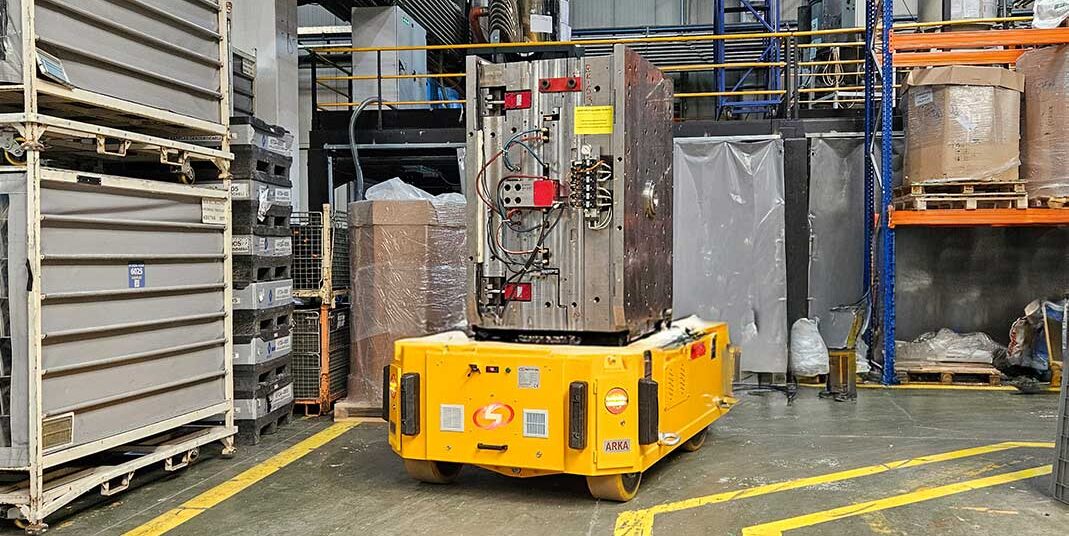Mold Transfer Carts

30-ton capacity mold transfer cart
Mold transfer carts (also known as die handling carts) are designed to safely transport molds, molding equipment, and other heavy materials within production facilities. Mold transfer carts are not only used for moving molds during mold changes but also for placing heavy parts onto shelves or facilitating maintenance and repair operations by moving them vertically or horizontally within the workshop. In other words, they provide horizontal movement and, thanks to the hydraulic lifting systems found in some models, also enable vertical motion to align the mold with the machine level.
These vehicles are widely used across various industries, from automotive and aerospace to metalworking and plastic injection. For example, in the automotive sector, they play a crucial role in transferring large sheet metal press molds between production lines, while in the plastics industry, they are essential for loading and unloading injection molds from machines. Mold transfer carts allow heavy molds to be transported quickly and safely from one production line to another, minimizing the need for manual labor during loading and unloading. As a result, they have become an indispensable part of a factory’s intralogistics flow.
Advantages of Mold Transfer Carts
The greatest advantage mold transfer carts provide to businesses is improved workplace safety. Molds that can weigh several tons pose a serious risk of accidents when transported manually or with improper equipment. The use of mold transfer carts minimizes accidents that may occur during manual handling of heavy loads, ensuring operator safety. Thanks to their ergonomic design, they reduce the physical strain on operators and lower the risk of injury. Moreover, mold handling can be safely performed by a single person, as the carts’ balance and lifting mechanisms reduce the need for manpower.
Another major benefit is the increase in efficiency and time savings. Mold changing and transportation processes are significantly accelerated, reducing downtime on production lines. Tasks that used to take hours using traditional methods can now be completed within minutes with the right mold transfer cart. For instance, when quick mold change systems are used, mold change times can be reduced by up to 80%, resulting in substantial productivity gains. The increase in operational speed also facilitates the effective implementation of lean manufacturing techniques such as SMED (Single Minute Exchange of Die). Fast mold changes minimize line stoppages, even in small-batch productions, thus enhancing overall productivity.
The improvement in efficiency also translates into cost savings. Mold transfer carts shorten processes, reduce the need for multiple operators, and thus lower labor costs. Previously, several workers might have been required to perform a task that now can be handled by one operator. Additionally, electric and battery-powered models increase energy efficiency, helping reduce operational energy costs while offering an eco-friendly solution. Their quiet and clean operation eliminates noise and emissions, contributing to a more sustainable and comfortable working environment.
In summary, mold transfer carts are highly beneficial equipment for businesses in terms of safety, speed, and cost-effectiveness. Their contribution to automation in production processes reduces human error and operational disruptions. With the right mold transfer system, a company can protect its workforce, increase its production capacity, and enhance its competitiveness.
Application Areas and Industries of Mold Transfer Carts
Mold transfer carts are primarily used in heavy industry and manufacturing sectors. The common factor among these industries is that the molds or tools used in production are large and heavy, requiring specialized systems for safe and efficient handling. Below are the main application areas and industries where these carts are widely utilized:
- Automotive Industry:
In the automotive sector, large sheet metal molds are used in press lines for vehicle body part production. These molds often need to be moved from one press machine to another or transferred to storage for maintenance. Mold transfer carts help reduce mold change times in automotive factories, minimizing production line downtime and increasing efficiency. At the same time, they prevent workplace accidents by ensuring the safe transportation of heavy molds. - Plastic Injection Industry:
Injection molds used in plastic part production are often made of steel and can be extremely heavy. In factories producing multiple product types, molds must frequently be changed on injection machines. Mold transfer carts enable fast loading and unloading of molds onto the machines. Special designs capable of maneuvering in tight spaces—such as side-loading carts—greatly facilitate mold change operations in plastic injection facilities. In plants without overhead cranes, mold transfer carts often provide the only safe and efficient solution for mold handling. - White Goods Industry:
In the production of washing machines, refrigerators, and dishwashers, both plastic injection molds and sheet metal forming dies are used. Because different models and components are produced frequently, mold transfer carts play a crucial role in maintaining uninterrupted production flow. They allow for the safe transport and precise positioning of large press molds along production lines, improving both efficiency and safety. - Metal Forming and Foundry Industries:
In metal cutting, forging, and foundry operations, large tools and molds must be regularly moved. Mold transfer carts are used to transport heavy casting molds to furnaces or place them onto presses. Since these environments often involve challenging conditions (such as high temperatures or confined spaces), durable and maneuverable mold transfer carts are preferred. They ensure even the heaviest and hottest materials are transported safely to their designated stations.
Beyond these examples, mold transfer carts are also used in the aerospace and defense industries wherever large molds, dies, or tooling systems need to be handled. Essentially, any industry that requires the regular movement of equipment weighing between 1 and 1000 tons can benefit from these systems. Depending on the facility layout and operational requirements, different types of mold transfer carts are available—such as rail-mounted, battery-powered steerable, or scissor-lift models. For example, rail-type carts are ideal for fixed routes, while battery-powered steerable carts are preferred in facilities requiring greater mobility. This allows each industry to achieve maximum efficiency through a tailor-made solution.
Comparison with Alternative Mold Handling Methods
Before the introduction of mold transfer carts, or in facilities where such systems were not available, companies used various methods to transport heavy molds. Traditionally, one of the most common methods was moving and replacing molds using an overhead crane. In this method, molds are lifted and placed onto machines with the help of chains attached to the crane. However, this process typically requires at least two operators and carries the risk of swinging or colliding molds if not handled carefully. Moreover, cranes are fixed in place, meaning that not every machine in a production line may be within their reach. Mold changes performed with cranes are usually time-consuming and often result in production downtime. In contrast, with the use of a suitable mold transfer cart, mold replacement can be performed easily even in areas without cranes, significantly reducing downtime. For instance, a mold change operation that takes 30–60 minutes with a traditional crane can be completed in as little as 10 minutes using a well-designed mold transfer cart — resulting in a 50–80% increase in production efficiency.
Another alternative method is the use of forklifts or similar handling vehicles. While forklifts may seem convenient for transporting small or medium-sized molds, they are not designed for this purpose and come with significant disadvantages. Lifting a heavy mold with a forklift can create an unbalanced load, increasing the risk of tipping over or dropping the mold. Operator errors and limited visibility can further lead to serious accidents. Thus, using forklifts for mold handling is both inefficient and potentially dangerous, especially for large or high-value molds.
Seyiton industrial transfer carts have been specifically developed to eliminate the risks and limitations of these traditional methods. Battery-powered models with high load capacities can safely transport up to 1000 tons, providing maximum operational safety through advanced features such as laser scanners and integrated safety systems. Their precise maneuverability and millimeter-level alignment capability ensure that molds can be positioned safely and accurately onto presses or storage stations. Integrated rail systems, hydraulic push-pull mechanisms, and special positioning solutions enable seamless, safe, and efficient operations throughout the production process.
